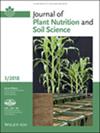Comparison of soil phosphorus extraction methods regarding their suitability for organic farming systems
Abstract
Background
Organic farmers frequently report sufficient yield levels despite low or even very low soil phosphorous (P) contents questioning the applicability of widely used laboratory methods for soil P testing for organic farming.
Aims
The aim of this study was to compare the validity of a broad range of different soil extraction methods on soils under organic management from South West Germany and to test the correlation of the measured soil P concentration with plant offtake.
Methods
Twenty-two soil samples of eight different organic farms were extracted with different solutions: (1) water, (2) CAL, (3) Olsen, (4) Mehlich 3, (5) Bray P1, (6) Bray P2, (7) NaOH+Na2EDTA, and (8) total P. The results were then correlated with above ground plant P.
Results
Spearman's rank correlation coefficient (rs) of correlations between above ground plant P and extractable soil P (Water-P, CAL-P, and Olsen-P [+active charcoal {+AC}]) determined with ICP-OES were strong (0.94, 0.90, and 0.93, respectively). Among the tested methods, above ground plant P showed a strong correlation with CAL-P as detected by ICP-OES (rs = 0.90) and colorimetry (rs = 0.91). The comparison of CAL-P data provided by farmers and CAL-P analyzed during this research showed discrepancies between the results.
Conclusions
The results of this study indicate that the CAL method can be used in organic farming despite a low extraction of organic P (Porg). Furthermore, it is recommended for farmers to take soil samples for analyses regularly and interpret changes in P in the long-term instead of interpreting individual samples.


 求助内容:
求助内容: 应助结果提醒方式:
应助结果提醒方式:


